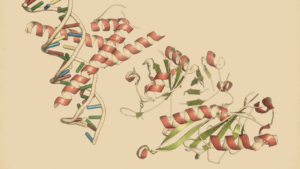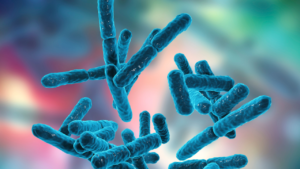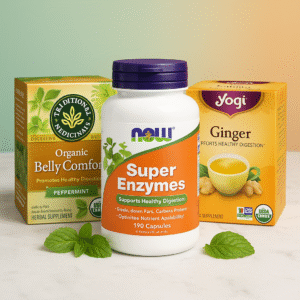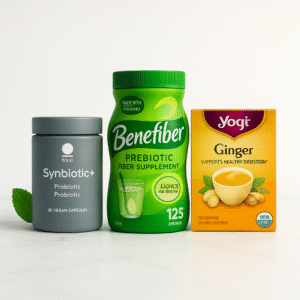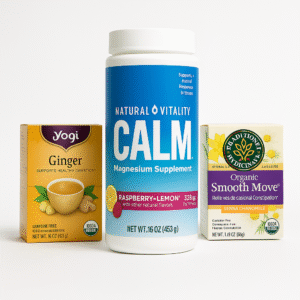Decoding Colorectal Cancer: Genetics and Environment
Explore the intricate relationship between genetics, environment, and colorectal cancer (CRC) to gain insights into its development and prevention.

Introduction
Colorectal cancer (CRC), is one of the most common types of cancer that affects people worldwide.
It's a significant health concern on a global scale.
To put it in perspective, CRC ranks third in terms of how often it occurs and second in terms of how deadly it can be.
In 2018 alone, there were 1.8 million new cases of CRC and sadly, it led to 881,000 deaths. Trusted Sourced Bray F, Ferlay J, Soerjomataram I, Siegel RL, Torre LA, Jemal A. Global cancer statistics 2018: GLOBOCAN estimates of incidence and mortality worldwide for 36 cancers in 185 countries. CA Cancer J Clin (2018) 68(6):394–424. doi: 10.3322/caac.21492 Experts predict that by 2030, the number of new cases will increase to 2.2 million, and the number of deaths will reach 1.1 million worldwide. Trusted Sourced Arnold M, Sierra MS, Laversanne M, Soerjomataram I, Jemal A, Bray F. Global patterns and trends in colorectal cancer incidence and mortality. Gut (2017) 66(4):683–91. doi: 10.1136/gutjnl-2015-310912 In China, over 376,000 new cases and 191,000 deaths are estimated to happen each year . Trusted Sourced Chen W, Zheng R, Baade PD, Zhang S, Zeng H, Bray F, et al. Cancer statistics in China, 2015. CA Cancer J Clin (2016) 66(2):115–32. doi: 10.3322/caac.21338Now, something interesting is happening.
CRC has been decreasing in older adults (those aged 65 and above) because more people are getting colonoscopies, a test that can find CRC early.
But, and this is concerning, the opposite is happening in younger adults, those under 50. Trusted Sourced Siegel RL, Miller KD, Fedewa SA, Ahnen DJ, Meester RGS, Barzi A, et al. Colorectal cancer statistics, 2017. CA Cancer J Clin (2017) 67(3):177–93. doi: 10.3322/caac.21395 In the United States, from the mid-1980s to 2013, the number of colon cancer cases increased every year by 2.4% in people aged 20-29, by 1.0% in people aged 30-39, by 1.3% in people aged 40-49, and by 0.5% in people aged 50-54. Trusted Sourced Siegel RL, Fedewa SA, Anderson WF, Miller KD, Ma J, Rosenberg PS, et al. Colorectal Cancer Incidence Patterns in the United States, 1974-2013. JNCI J Natl Cancer Inst (2017) 109(8):djw322. doi: 10.1093/jnci/djw322 Trusted Sourced Song M, Chan AT, Sun J. Influence of the Gut Microbiome, Diet, and Environment on Risk of Colorectal Cancer. Gastroenterology (2020) 158(2):322–40. doi: 10.1053/j.gastro.2019.06.048This is a worrying trend, and we need new ways to find and prevent CRC early.
CRC is a tricky disease because it's caused by a mix of things, some that you inherit from your family and others that come from your environment. Trusted Sourced Louis P, Hold GL, Flint HJ. The gut microbiota, bacterial metabolites and colorectal cancer. Nat Rev Microbiol (2014) 12(10):661–72. doi: 10.1038/nrmicro3344 Only a small number of CRC cases are due to things you inherit, like familial adenomatous polyposis (FAP) and Lynch syndrome. Trusted Sourced Czene K, Lichtenstein P, Hemminki K. Environmental and heritable causes of cancer among 9.6 million individuals in the Swedish Family-Cancer Database. Int J Cancer (2002) 99(2):260–6. doi: 10.1002/ijc.10332 Trusted Sourced Rustgi AK. The genetics of hereditary colon cancer. Genes Dev (2007) 21(20):2525–38. doi: 10.1101/gad.1593107 Trusted Sourced Foulkes WD. Inherited susceptibility to common cancers. N Engl J Med (2008) 359(20):2143–53. doi: 10.1056/NEJMra0802968 Most CRCs just happen, they're not inherited Trusted Sourced Drewes JL, Housseau F, Sears CL. Sporadic colorectal cancer: microbial contributors to disease prevention, development and therapy. Br J Cancer (2016) 115(3):273–80. doi: 10.1038/bjc.2016.189The things in the environment, like the food you eat, whether you smoke, your weight, and alcohol, play a big role in causing non-inherited CRC.
One interesting thing is that the bacteria in your gut, called the intestinal microbiota, also have something to say about CRC. Trusted Sourced Nakatsu G, Li X, Zhou H, Sheng J, Wong SH, Wu WKK, et al. Gut mucosal microbiome across stages of colorectal carcinogenesis. Nat Commun (2015) 6:8727–7. doi: 10.1038/ncomms9727 Trusted Sourced Yu J, Feng Q, Wong SH, Zhang D, Liang QY, Qin Y, et al. Metagenomic analysis of faecal microbiome as a tool towards targeted non-invasive biomarkers for colorectal cancer. Gut (2017) 66(1):70–8. doi: 10.1136/gutjnl-2015-309800 Trusted Sourced Nakatsu G, Zhou H, Wu WKK, Wong SH, Coker OO, Dai Z, et al. Alterations in Enteric Virome Are Associated With Colorectal Cancer and Survival Outcomes. Gastroenterology (2018) 155(2):529–541 e525. doi: 10.1053/j.gastro.2018.04.018 Trusted Sourced Coker OO, Nakatsu G, Dai RZ, Wu WKK, Wong SH, Ng SC, et al. Enteric fungal microbiota dysbiosis and ecological alterations in colorectal cancer. Gut (2019) 68(4):654–62. doi: 10.1136/gutjnl-2018-317178 There are trillions of these tiny bacteria in your gut, way more than human cells in your body, and they have lots of genes. Trusted Sourced Gill SR, Pop M, Deboy RT, Eckburg PB, Turnbaugh PJ, Samuel BS, et al. Metagenomic analysis of the human distal gut microbiome. Sci (N Y NY) (2006) 312(5778):1355–9. doi: 10.1126/science.1124234 Trusted Sourced Tsai Y-L, Lin T-L, Chang C-J, Wu T-R, Lai W-F, Lu C-C, et al. Probiotics, prebiotics and amelioration of diseases. J BioMed Sci (2019) 26(1):3–3. doi: 10.1186/s12929-018-0493-6 These bacteria do some important things like helping you digest food, keeping your gut healthy, and fighting off bad germs. Trusted Sourced den Besten G, van Eunen K, Groen AK, Venema K, Reijngoud DJ, Bakker BM. The role of short-chain fatty acids in the interplay between diet, gut microbiota, and host energy metabolism. J Lipid Res (2013) 54(9):2325–40. doi: 10.1194/jlr.R036012 Trusted Sourced Natividad JM, Verdu EF. Modulation of intestinal barrier by intestinal microbiota: pathological and therapeutic implications. Pharmacol Res (2013) 69(1):42–51. doi: 10.1016/j.phrs.2012.10.007 Trusted Sourced Bäumler AJ, Sperandio V. Interactions between the microbiota and pathogenic bacteria in the gut. Nature (2016) 535(7610):85–93. doi: 10.1038/nature18849 Trusted Sourced Gensollen T, Iyer SS, Kasper DL, Blumberg RS. How colonization by microbiota in early life shapes the immune system. Science (2016) 352(6285):539–44. doi: 10.1126/science.aad9378But if they get out of balance, it can lead to health problems (24).
But if they get out of balance, it can lead to health problems. Trusted Sourced Helmink BA, Khan MAW, Hermann A, Gopalakrishnan V, Wargo JA. The microbiome, cancer, and cancer therapy. Nat Med (2019) 25(3):377–88. doi: 10.1038/s41591-019-0377-7Scientists are now looking at how these gut bacteria are connected to CRC.
They've found differences in the types of bacteria in people with CRC and those without.
It's interesting that these differences start even before CRC does, in the early stage called colorectal adenoma.
So, they might be able to use these changes in the bacteria as signs to find CRC early.
Another interesting idea is that maybe we can change the bacteria in your gut to help prevent or treat CRC.
The process of how CRC develops is very complicated and involves a mix of genetics and environment.
Recent studies suggest that things like inflammation, bad bacteria, harmful substances, and more are connected to how gut bacteria affect CRC.
This article reviews what we know so far about these connections.
Key Points
- Complex Colorectal Carcinogenesis: Colorectal cancer is a highly complex disease influenced by a combination of genetic and environmental factors.
- Microbiota-Associated Mechanisms: Emerging studies highlight the critical role of intestinal microbiota in colorectal cancer development, involving inflammation, pathogenic bacteria, genotoxins, oxidative stress, and metabolites.
- Chronic Inflammation: Chronic inflammation is a significant risk factor for colorectal cancer, particularly in patients with inflammatory bowel diseases like ulcerative colitis and Crohn's disease.
- Bacterial Impact: Specific pathogenic bacteria, including Fusobacterium nucleatum, Enterotoxigenic Bacteroides fragilis (ETBF), Porphyromonas anaerobius, and Salmonella bovis, contribute to colorectal cancer progression through various mechanisms.
- Diet and Microbiota: Dietary choices significantly influence colorectal cancer risk by shaping the gut microbiota composition and the production of metabolites, with butyrate being a notable protective factor.
Mechanism of Colorectal Cancer
Colorectal carcinogenesis is highly complex and involves genetic and environmental factors.
Emerging studies suggest that several mechanisms, including inflammation, pathogenic bacteria, genotoxins, oxidative stress, metabolites, and biofilm, are closely linked to the intestinal microbiota.
Here, we review the known microbiota-associated mechanisms in CRC carcinogenesis
Inflammation and Cancer
Understanding the Connection
The link between inflammation and cancer was first observed by Rudolf Virchow in 1863 when he noted the presence of leukocytes in tumors. Trusted Sourced Balkwill F, Mantovani A. Inflammation and cancer: back to Virchow? Lancet (2001) 357(9255):539–45. doi: 10.1016/s0140-6736(00)04046-0However, it's only in the past decade that clear evidence has emerged showing that inflammation plays a critical role in the development of cancer.
Chronic Inflammation and CRC
Chronic inflammation is widely recognized as a significant risk factor for colorectal cancer (CRC). Trusted Sourced Hanahan D, Weinberg RA. Hallmarks of cancer: the next generation. Cell (2011) 144(5):646–74. doi: 10.1016/j.cell.2011.02.013 Trusted Sourced Beaugerie L, Itzkowitz SH. Cancers complicating inflammatory bowel disease. N Engl J Med (2015) 372(15):1441–52. doi: 10.1056/NEJMra1403718 Trusted Sourced Brennan CA, Garrett WS. Gut Microbiota, Inflammation, and Colorectal Cancer. Annu Rev Microbiol (2016) 70(1):395–411. doi: 10.1146/annurev-micro-102215-095513Patients with inflammatory bowel disease (IBD), including ulcerative colitis (UC) and Crohn's disease (CD), face a higher risk of developing CRC.
Previous studies have shown that the risk of CRC can increase significantly, up to 18.4% in UC patients and 8.3% in CD patients. Trusted Sourced Eaden JA, Abrams KR, Mayberry JF. The risk of colorectal cancer in ulcerative colitis: a meta-analysis. Gut (2001) 48(4):526–35. doi: 10.1136/gut.48.4.526 Trusted Sourced Canavan C, Abrams KR, Mayberry J. Meta-analysis: colorectal and small bowel cancer risk in patients with Crohn’s disease. Aliment Pharmacol Ther (2006) 23(8):1097–104. doi: 10.1111/j.1365-2036.2006.02854.xThe Microbiota and Immune System
The intestinal microbiota, the community of bacteria in our gut, has a close relationship with our immune system.
When bacteria stimulate immune responses, it can lead to continuous low-grade inflammation, which can contribute to tumorigenesis.
Importantly, inflammation alone cannot induce CRC without the presence of the microbiota or bacteria-derived compounds. Trusted Sourced Arthur JC, Perez-Chanona E, Mühlbauer M, Tomkovich S, Uronis JM, Fan TJ, et al. Intestinal inflammation targets cancer-inducing activity of the microbiota. Science (2012) 338(6103):120–3. doi: 10.1126/science.1224820The Role of the Intestinal Mucosal Barrier
Maintaining Gut Health
The intestinal mucosal barrier serves as a protective shield, separating the intestinal microbiota from our immune cells.
This barrier consists of a single layer of intestinal epithelial cells (IECs) connected by tight junctions. Trusted Sourced Lee TC, Huang YC, Lu YZ, Yeh YC, Yu LC. Hypoxia-induced intestinal barrier changes in balloon-assisted enteroscopy. J Physiol (2018) 596(15):3411–24. doi: 10.1113/jp275277 However, in both human and CRC mouse models, this barrier can become highly permeable. Trusted Sourced Grivennikov SI, Wang K, Mucida D, Stewart CA, Schnabl B, Jauch D, et al. Adenoma-linked barrier defects and microbial products drive IL-23/IL-17-mediated tumour growth. Nature (2012) 491(7423):254–8. doi: 10.1038/nature11465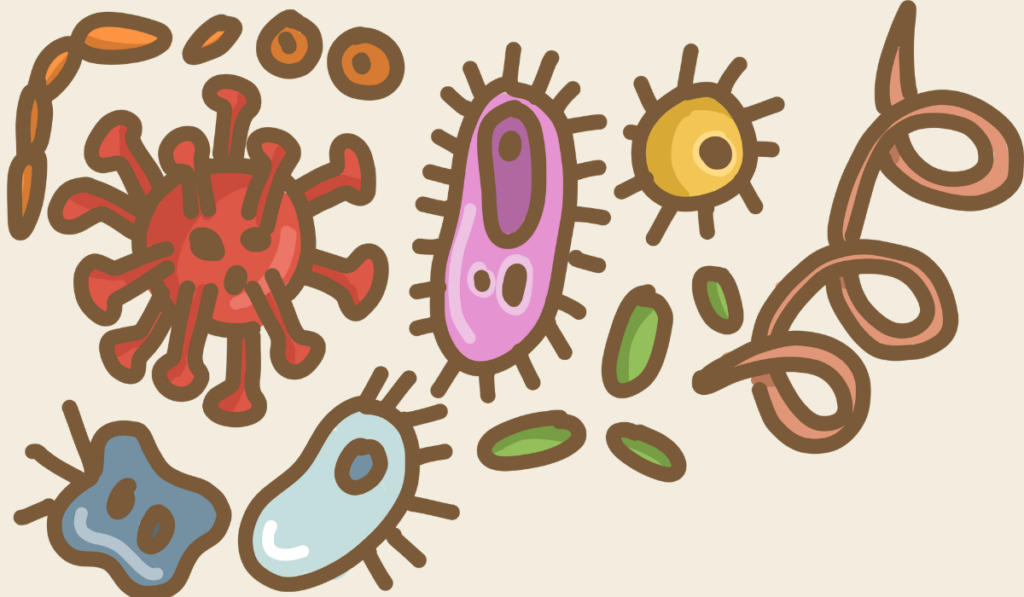
Disruption and Vulnerability
Disrupting the function of the intestinal mucosal barrier, often induced experimentally by substances like dextran sodium sulfate (DSS), can lead to increased susceptibility to CRC. Trusted Sourced Tanaka T, Kohno H, Suzuki R, Hata K, Sugie S, Niho N, et al. Dextran sodium sulfate strongly promotes colorectal carcinogenesis in Apc(Min/+) mice: inflammatory stimuli by dextran sodium sulfate results in development of multiple colonic neoplasms. Int J Cancer (2006) 118(1):25–34. doi: 10.1002/ijc.21282Specific factors like matriptase, a membrane-anchored serine protease, play a role in maintaining the barrier's integrity.
When matriptase is absent, it can lead to the development of CRC. Trusted Sourced Kosa P, Szabo R, Molinolo AA, Bugge TH. Suppression of Tumorigenicity-14, encoding matriptase, is a critical suppressor of colitis and colitis-associated colon carcinogenesis. Oncogene (2012) 31(32):3679–95. doi: 10.1038/onc.2011.545Microbiota Invasion
Transformed IECs, which are cells in the intestinal lining that have become cancerous, often fail to create an effective surface barrier.
This allows commensal bacteria and their degradation products to invade the tumor stoma.
Our bodies recognize these bacteria through pattern recognition receptors (PRRs), like Toll-like receptors (TLRs).
These receptors control the inflammatory response to bacterial molecules, such as lipopolysaccharide. Trusted Sourced Goodman B, Gardner H. The microbiome and cancer. J Pathol (2018) 244(5):667–76. doi: 10.1002/path.5047The Inflammatory Response
Cytokines and Signaling
When invading commensal bacteria and their components engage TLRs on tumor-infiltrating myeloid cells, it triggers the production of inflammatory cytokines, including interleukin (IL)-23.
IL-23 then leads to the production of other cytokines like IL-17A, IL-6, and IL-22. Trusted Sourced Song X, Gao H, Lin Y, Yao Y, Zhu S, Wang J, et al. Alterations in the Microbiota Drive Interleukin-17C Production from Intestinal Epithelial Cells to Promote Tumorigenesis. Immunity (2014) 40(1):140–52. doi: 10.1016/j.immuni.2013.11.018 Trusted Sourced Cremonesi E, Governa V, Garzon JFG, Mele V, Amicarella F, Muraro MG, et al. Gut microbiota modulate T cell trafficking into human colorectal cancer. Gut (2018) 67(11):1984–94. doi: 10.1136/gutjnl-2016-313498 These cytokines ultimately promote the proliferation of tumor cells by activating signaling pathways like nuclear factor-kB (NF-kB) and STAT3. Trusted Sourced Kortylewski M, Xin H, Kujawski M, Lee H, Liu Y, Harris T, et al. Regulation of the IL-23 and IL-12 Balance by Stat3 Signaling in the Tumor Microenvironment. Cancer Cell (2009) 15(2):114–23. doi: 10.1016/j.ccr.2008.12.018 Trusted Sourced Wang K, Min K, Di Caro G, Wong J, Shalapour S, Wan J, et al. Interleukin-17 Receptor A Signaling in Transformed Enterocytes Promotes Early Colorectal Tumorigenesis. Immunity (2014) 41(6):1052–63. doi: 10.1016/j.immuni.2014.11.009Microbiota-Induced Survival
Commensal bacteria and their components can also upregulate IL-17C in transformed IECs.
This activation, driven by TLRs and MyD88 signaling, induces the expression of genes like B-cell lymphoma-2 (Bcl-2) and Bcl-xL within IECs.
These genes support tumor cell survival and tumorigenesis. Trusted Sourced Song X, Gao H, Lin Y, Yao Y, Zhu S, Wang J, et al. Alterations in the Microbiota Drive Interleukin-17C Production from Intestinal Epithelial Cells to Promote Tumorigenesis. Immunity (2014) 40(1):140–52. doi: 10.1016/j.immuni.2013.11.018Specific Microbes and CRC
F. nucleatum and CRC
Fusobacterium nucleatum (F. nucleatum) contributes to CRC progression by creating a pro-inflammatory environment.
It activates the NF-kB pathway and recruits immune cells when enriched in CRC. Trusted Sourced Ye X, Wang R, Bhattacharya R, Boulbes DR, Fan F, Xia L, et al. Fusobacterium Nucleatum Subspecies Animalis Influences Proinflammatory Cytokine Expression and Monocyte Activation in Human Colorectal Tumors. Cancer Prev Res (Phila) (2017) 10(7):398–409. doi: 10.1158/1940-6207.capr-16-0178ETBF and Its Impact
Enterotoxigenic Bacteroides fragilis (ETBF) promotes colonic cancer through various mechanisms. It secretes a toxin that disrupts the colonic barrier and activates STAT3, leading to CRC characterized by Th17 responses. Trusted Sourced Wu S, Rhee KJ, Albesiano E, Rabizadeh S, Wu X, Yen HR, et al. A human colonic commensal promotes colon tumorigenesis via activation of T helper type 17 T cell responses. Nat Med (2009) 15(9):1016–22. doi: 10.1038/nm.2015 Additionally, ETBF generates particles that stimulate IECs to produce chemokines required for Th17 cell recruitment and the proliferation of IL-17 signals, supporting tumor growth. Trusted Sourced Deng Z, Mu J, Tseng M, Wattenberg B, Zhuang X, Egilmez NK, et al. Enterobacteria-secreted particles induce production of exosome-like S1P-containing particles by intestinal epithelium to drive Th17-mediated tumorigenesis. Nat Commun (2015) 6:6956–6. doi: 10.1038/ncomms7956
P. anaerobius and Tumorigenesis
Porphyromonas anaerobius (P. anaerobius) provokes a pro-inflammatory immune microenvironment that promotes tumorigenesis.
In ApcMin/+ mice, P. anaerobius broadly induces pro-inflammatory cytokine expression, recruiting tumor-infiltrating immune cells and supporting tumor progression. Trusted Sourced Long X, Wong CC, Tong L, Chu ESH, Ho Szeto C, Go MYY, et al. Peptostreptococcus anaerobius promotes colorectal carcinogenesis and modulates tumour immunity. Nat Microbiol (2019) 4(12):2319–30. doi: 10.1038/s41564-019-0541-3Pathogenic Bacteria in Colorectal Cancer
The Role of Bacterial Adherence
In the world of colorectal cancer, certain pesky bacteria have been identified as troublemakers.
They make themselves at home on the mucosal surface of the colon, and their attachment is often the first step towards causing trouble.
F. nucleatum: An Early Culprit
One such troublemaker is Fusobacterium nucleatum, which is usually found in our mouths.
It starts causing problems early in the development of colorectal cancer. Scientists discovered that F. nucleatum sticks to the colon lining and triggers cancer through a special protein called Fusobacterium adhesin A (FadA).
FadA likes to bind to a protein called E-cadherin and activates a pathway called beta-catenin signaling.
This pathway encourages cancerous and inflammatory responses. Trusted Sourced Rubinstein MR, Wang X, Liu W, Hao Y, Cai G, Han YW. Fusobacterium nucleatum Promotes Colorectal Carcinogenesis by Modulating E-Cadherin/β-Catenin Signaling via its FadA Adhesin. Cell Host Microbe (2013) 14(2):195–206. doi: 10.1016/j.chom.2013.07.012F. nucleatum: The Immune System's Nemesis
But that's not all. F. nucleatum also dampens our immune system's abilities.
It has another protein on its surface called Fap2, which likes to stick to a part of our immune cells.
This slows down our T cells and natural killer cells, which are important in fighting off diseases.
Fap2 can even lead to the production of inflammatory proteins like IL-8 and CXCL1, which help cancer cells move around. Trusted Sourced Gur C, Ibrahim Y, Isaacson B, Yamin R, Abed J, Gamliel M, et al. Binding of the Fap2 protein of Fusobacterium nucleatum to human inhibitory receptor TIGIT protects tumors from immune cell attack. Immunity (2015) 42(2):344–55. doi: 10.1016/j.immuni.2015.01.010 Trusted Sourced Casasanta MA, Yoo CC, Udayasuryan B, Sanders BE, Umaña A, Zhang Y, et al. Fusobacterium nucleatum host-cell binding and invasion induces IL-8 and CXCL1 secretion that drives colorectal cancer cell migration. Sci Signal (2020) 13(641). doi: 10.1126/scisignal.aba9157F. nucleatum: Playing with Autophagy
F. nucleatum doesn't stop there; it also tinkers with a process called autophagy in the cells lining our colon.
This happens through tiny molecules called microRNAs. Trusted Sourced Yang Y, Weng W, Peng J, Hong L, Yang L, Toiyama Y, et al. Fusobacterium nucleatum Increases Proliferation of Colorectal Cancer Cells and Tumor Development in Mice by Activating Toll-Like Receptor 4 Signaling to Nuclear Factor-κB, and Up-regulating Expression of MicroRNA-21. Gastroenterology (2017) 152851-866(4):e824. doi: 10.1053/j.gastro.2016.11.018 Trusted Sourced Yu T, Guo F, Yu Y, Sun T, Ma D, Han J, et al. Fusobacterium nucleatum Promotes Chemoresistance to Colorectal Cancer by Modulating Autophagy. Cell (2017) 170(3):548–563.e516. doi: 10.1016/j.cell.2017.07.008P. anaerobius: Another Accomplice
There's another bacterial troublemaker named Porphyromonas anaerobius, which normally hangs out in our mouths and gut.
It promotes the growth of colorectal cancer in a unique way.
It has a protein called putative cell wall binding repeat 2 (PCWBR2) that likes to stick to the cells lining our intestines.
When it does this, it kicks off a chain reaction that encourages the rapid growth of cancer cells through a pathway called PI3K-Akt signaling. Trusted Sourced Long X, Wong CC, Tong L, Chu ESH, Ho Szeto C, Go MYY, et al. Peptostreptococcus anaerobius promotes colorectal carcinogenesis and modulates tumour immunity. Nat Microbiol (2019) 4(12):2319–30. doi: 10.1038/s41564-019-0541-3S. bovis: The Inflammation Link
Salmonella bovis occasionally shows up in our gut, and it's more common in people with colorectal cancer.
It seems to contribute to cancer by causing inflammation.
It's thought to do this by triggering the production of inflammatory substances like IL1, cyclooxygenase-2 (COX-2), and IL-8. Trusted Sourced Biarc J, Nguyen IS, Pini A, Gossé F, Richert S, Thiersé D, et al. Carcinogenic properties of proteins with pro-inflammatory activity from Streptococcus infantarius (formerly S.bovis ). Carcinogenesis (2004) 25(8):1477–84. doi: 10.1093/carcin/bgh091 Trusted Sourced Abdulamir AS, Hafidh RR, Bakar FA. Molecular detection, quantification, and isolation of Streptococcus gallolyticus bacteria colonizing colorectal tumors: inflammation-driven potential of carcinogenesis via IL-1, COX-2, and IL-8. Mol Cancer (2010) 9:249–9. doi: 10.1186/1476-4598-9-249Salmonella's Chronic Trouble
Speaking of Salmonella, its infection in humans can become a long-term issue, increasing the risk of cancer.
Salmonella seems to promote colon cancer by using a protein called AvrA.
This sneaky protein activates two important pathways, Wnt/beta-catenin and STAT3, in colon tumor cells. Trusted Sourced Lu R, Wu S, Zhang YG, Xia Y, Liu X, Zheng Y, et al. Enteric bacterial protein AvrA promotes colonic tumorigenesis and activates colonic beta-catenin signaling pathway. Oncogenesis (2014) 3(6):e105. doi: 10.1038/oncsis.2014.20 Trusted Sourced Lu R, Wu S, Zhang Y-G, Xia Y, Zhou Z, Kato I, et al. Salmonella Protein AvrA Activates the STAT3 Signaling Pathway in Colon Cancer. Neoplasia (N Y NY) (2016) 18(5):307–16. doi: 10.1016/j.neo.2016.04.001 Trusted Sourced Wang J, Lu R, Fu X, Dan Z, Zhang Y-G, Chang X, et al. Novel Regulatory Roles of Wnt1 in Infection-Associated Colorectal Cancer. Neoplasia (N Y NY) (2018) 20(5):499–509. doi: 10.1016/j.neo.2018.03.001Genotoxins: The DNA Damage Agents
Bacterial Origins of Genotoxins
Let's talk about genotoxins - these are substances produced by certain bacteria that can seriously damage our DNA, which is like the instruction manual for our cells.
Some of these bacteria are connected to the development of colorectal cancer.
E. coli and Colibactin
One troublemaker is E. coli, a common bacteria found in our gut.
Some strains of E. coli have a special part of their DNA called a genomic island.
This island contains the code for making a genotoxin called colibactin. Trusted Sourced Cuevas-Ramos G, Petit CR, Marcq I, Boury M, Oswald E, Nougayrède JP. Escherichia coli induces DNA damage in vivo and triggers genomic instability in mammalian cells. Proc Natl Acad Sci U.S.A. (2010) 107(25):11537–42. doi: 10.1073/pnas.1001261107 Trusted Sourced Arthur JC, Gharaibeh RZ, Mühlbauer M, Perez-Chanona E, Uronis JM, McCafferty J, et al. Microbial genomic analysis reveals the essential role of inflammation in bacteria-induced colorectal cancer. Nat Commun (2014) 5:4724. doi: 10.1038/ncomms5724 When cultured mammalian cells are exposed to E. coli carrying this island, it can cause temporary but harmful damage to their DNA. Trusted Sourced Cuevas-Ramos G, Petit CR, Marcq I, Boury M, Oswald E, Nougayrède JP. Escherichia coli induces DNA damage in vivo and triggers genomic instability in mammalian cells. Proc Natl Acad Sci U.S.A. (2010) 107(25):11537–42. doi: 10.1073/pnas.1001261107In studies using mice, researchers found that colibactin can make cells become old and stop working correctly.
This leads to the production of a growth factor called hepatocyte growth factor, which, in turn, boosts the growth of tumor cells. Trusted Sourced Cougnoux A, Dalmasso G, Martinez R, Buc E, Delmas J, Gibold L, et al. Bacterial genotoxin colibactin promotes colon tumour growth by inducing a senescence-associated secretory phenotype. Gut (2014) 63(12):1932–42. doi: 10.1136/gutjnl-2013-305257Campylobacter jejuni and Cytolethal Distending Toxin
Another troublemaker is Campylobacter jejuni.
It produces a genotoxin called cytolethal distending toxin, which can cause breaks in the double-stranded DNA in our cells.
This damage promotes the development of colorectal tumors. Trusted Sourced Lasry A, Zinger A, Ben-Neriah Y. Inflammatory networks underlying colorectal cancer. Nat Immunol (2016) 17(3):230–40. doi: 10.1038/ni.3384Salmonella and Typhoid Toxin
Even Salmonella, the bacteria famous for causing food poisoning, has its own genotoxin called typhoid toxin.
This toxin can harm DNA by affecting a pathway in the cells lining our colon called the PI3K pathway. Trusted Sourced Martin OCB, Bergonzini A, D’Amico F, Chen P, Shay JW, Dupuy J, et al. Infection with genotoxin-producing Salmonella enterica synergises with loss of the tumour suppressor APC in promoting genomic instability via the PI3K pathway in colonic epithelial cells. Cell Microbiol (2019) 21(12):e13099–9. doi: 10.1111/cmi.13099Oxidative Stress: The Balancing Act
What is Oxidative Stress?
Let's talk about oxidative stress - it's like a seesaw in your body.
On one side, you have molecules called prooxidants, such as reactive oxygen species (ROS) and reactive nitrogen species (RNS).
On the other side, you have defenders called antioxidants.
When the seesaw tips too much towards the prooxidants, that's when you get oxidative stress.
Oxidative Stress in Chronic Inflammation
Oxidative stress is often seen when your body is dealing with long-term inflammation, like the kind caused by the intestinal microbiota - those tiny organisms living in your gut.
Inflammation can rev up your body's inflammatory cells, and these cells produce a bunch of ROS and RNS.
These troublemakers can harm your DNA and do sneaky things like turning on cancer-causing genes or turning off cancer-fighting ones.
This is why oxidative stress is linked to an increased risk of colorectal cancer.
Microbes and Oxidative Stress
But here's the twist - it's not just your body's cells that can cause oxidative stress.
The bacteria living in your gut can also be culprits.
For example, a bacterium called E. faecalis can cause trouble.
When it infects certain immune cells, it causes them to make a powerful troublemaker called superoxide.
This superoxide then damages the DNA in the cells lining your gut - it's like a domino effect. Trusted Sourced de Almeida CV, Taddei A, Amedei A. The controversial role of Enterococcus faecalis in colorectal cancer. Therap Adv Gastroenterol (2018) 11:1756284818783606. doi: 10.1177/1756284818783606 Trusted Sourced Wang X, Huycke MM. Extracellular superoxide production by Enterococcus faecalis promotes chromosomal instability in mammalian cells. Gastroenterology (2007) 132(2):551–61. doi: 10.1053/j.gastro.2006.11.040The Role of Hydroxyl Radicals
Another sneaky move comes from a bacterium called E. faecalis.
It can produce hydroxyl radicals, which are like DNA wrecking balls.
They cause breaks in your DNA, change the DNA code, and even stick proteins to your DNA - it's a recipe for instability in your chromosomes and an increased risk of colorectal cancer. Trusted Sourced Huycke MM, Moore D, Joyce W, Wise P, Shepard L, Kotake Y, et al. Extracellular superoxide production by Enterococcus faecalis requires demethylmenaquinone and is attenuated by functional terminal quinol oxidases. Mol Microbiol (2001) 42(3):729–40. doi: 10.1046/j.1365-2958.2001.02638.x Trusted Sourced Huycke MM, Moore DR. In vivo production of hydroxyl radical by Enterococcus faecalis colonizing the intestinal tract using aromatic hydroxylation. Free Radic Biol Med (2002) 33(6):818–26. doi: 10.1016/s0891-5849(02)00977-2 Trusted Sourced Evans MD, Dizdaroglu M, Cooke MS. Oxidative DNA damage and disease: induction, repair and significance. Mutat Res (2004) 567(1):1–61. doi: 10.1016/j.mrrev.2003.11.001More Bacteria, More Trouble

Even bacteria like E. coli and a toxin from Enterotoxigenic Bacteroides fragilis (ETBF) can join the oxidative stress party.
They encourage the cells lining your colon to produce more ROS.
It's like they're turning up the heat, and that's not good news for your gut. Trusted Sourced Goodwin AC, Destefano Shields CE, Wu S, Huso DL, Wu X, Murray-Stewart TR, et al. Polyamine catabolism contributes to enterotoxigenic Bacteroides fragilis-induced colon tumorigenesis. Proc Natl Acad Sci U.S.A. (2011) 108(37):15354–9. doi: 10.1073/pnas.1010203108 Trusted Sourced Elatrech I, Marzaioli V, Boukemara H, Bournier O, Neut C, Darfeuille-Michaud A, et al. Escherichia coli LF82 differentially regulates ROS production and mucin expression in intestinal epithelial T84 cells: implication of NOX1. Inflammation Bowel Dis (2015) 21(5):1018–26. doi: 10.1097/mib.0000000000000365HIGHLIGHT
Oxidative stress is like a seesaw that should be in balance, but when it tips too far, it can lead to DNA damage and increase the risk of colorectal cancer. Those little microbes in your gut can sometimes play a big role in this tricky balancing act.
Diet and Bacteria Metabolites: Impact on Colorectal Cancer
The Link Between Diet and CRC
Did you know that your diet can significantly influence your risk of developing colorectal cancer (CRC)?
A recent study found that poor diets, characterized by low consumption of whole grains and dairy products and high intake of red and processed meats, were responsible for 38.3% of CRC cases. Trusted Sourced Zhang FF, Cudhea F, Shan Z, Michaud DS, Imamura F, Eom H, et al. Preventable Cancer Burden Associated With Poor Diet in the United States. JNCI Cancer Spectr (2019) 3(2):pkz034. doi: 10.1093/jncics/pkz034 Obesity and being overweight are also significant risk factors for CRC, increasing the risk by 19%. Trusted Sourced Lauby-Secretan B, Scoccianti C, Loomis D, Grosse Y, Bianchini F, Straif K, et al. Body Fatness and Cancer–Viewpoint of the IARC Working Group. N Engl J Med (2016) 375(8):794–8. doi: 10.1056/NEJMsr1606602The Role of Microbiota in Diet-CRC Connection
Your gut is home to a vast community of microorganisms known as the microbiota, and it plays a crucial role in the relationship between diet and CRC.
It acts as a mediator between the food you eat and its impact on your health.
Microbiota and Diet Diversity
Different diets can shape the composition of your intestinal microbiota.
For instance, diets high in animal protein and fat tend to favor the growth of bacteria like Bacteroides, while diets rich in carbohydrates encourage the dominance of bacteria like Prevotella. Trusted Sourced De Filippo C, Cavalieri D, Di Paola M, Ramazzotti M, Poullet JB, Massart S, et al. Impact of diet in shaping gut microbiota revealed by a comparative study in children from Europe and rural Africa. Proc Natl Acad Sci U.S.A. (2010) 107(33):14691–6. doi: 10.1073/pnas.1005963107 Trusted Sourced Wu GD, Chen J, Hoffmann C, Bittinger K, Chen Y-Y, Keilbaugh SA, et al. Linking long-term dietary patterns with gut microbial enterotypes. Sci (N Y NY) (2011) 334(6052):105–8. doi: 10.1126/science.1208344The Power of Microbial Metabolism
The microbiota also plays a role in breaking down undigested dietary components, such as fructo-oligosaccharides.
As a result, it generates various metabolic products, including short-chain fatty acids (SCFAs) like acetate, butyrate, and propionate.
Butyrate: A Cancer Fighter
Among these SCFAs, butyrate stands out as a potent protector against cancer.
It's primarily produced by Firmicutes when they ferment dietary fiber and resistant starches.
Butyrate serves as the primary energy source for the cells lining your colon, and it helps regulate their growth.
Importantly, butyrate can inhibit harmful processes in colon cells, such as inflammation and uncontrolled cell growth. Trusted Sourced Fung KYC, Cosgrove L, Lockett T, Head R, Topping DL. A review of the potential mechanisms for the lowering of colorectal oncogenesis by butyrate. Br J Nutr (2012) 108(5):820–31. doi: 10.1017/S0007114512001948 Trusted Sourced Chang PV, Hao L, Offermanns S, Medzhitov R. The microbial metabolite butyrate regulates intestinal macrophage function via histone deacetylase inhibition. Proc Natl Acad Sci U.S.A. (2014) 111(6):2247–52. doi: 10.1073/pnas.1322269111SCFAs and a Healthy Gut
SCFAs, especially butyrate, also have the power to lower the pH in your colon, making it less hospitable for harmful bacteria.
This helps prevent DNA damage and encourages cell apoptosis (cell death), which is essential for cancer prevention. Trusted Sourced Sánchez-Alcoholado L, Ramos-Molina B, Otero A, Laborda-Illanes A, Ordóñez R, Medina JA, et al. The Role of the Gut Microbiome in Colorectal Cancer Development and Therapy Response. Cancers (2020) 12(6):1406. doi: 10.3390/cancers12061406Bile Acids and Dietary Influence
Bile acids, which play a role in fat digestion, are another aspect of microbial metabolism influenced by diet.
High-fat diets can lead to an increase in secondary bile acids in your gut, and this is associated with a higher CRC risk. Trusted Sourced Ou J, DeLany JP, Zhang M, Sharma S, O’Keefe SJ. Association between low colonic short-chain fatty acids and high bile acids in high colon cancer risk populations. Nutr Cancer (2012) 64(1):34–40. doi: 10.1080/01635581.2012.630164 Trusted Sourced Ou J, Carbonero F, Zoetendal EG, DeLany JP, Wang M, Newton K, et al. Diet, microbiota, and microbial metabolites in colon cancer risk in rural Africans and African Americans. Am J Clin Nutr (2013) 98(1):111–20. doi: 10.3945/ajcn.112.056689Fat and Bile Acid Connection
Research has shown that diets high in fat can lead to an increase in secondary bile acids in the colon, contributing to a higher risk of CRC.
Studies in mice have linked a Western-style high-fat diet to an increased risk of colon tumors, highlighting the impact of dietary choices. Trusted Sourced Dermadi D, Valo S, Ollila S, Soliymani R, Sipari N, Pussila M, et al. Western Diet Deregulates Bile Acid Homeostasis, Cell Proliferation, and Tumorigenesis in Colon. Cancer Res (2017) 77(12):3352–63. doi: 10.1158/0008-5472.can-16-2860Nitroso Compounds and Hydrogen Sulfide
Diets rich in protein can lead to the production of harmful compounds like N-nitroso compounds (NOCs) and hydrogen sulfide (H2S).
These compounds have been associated with an increased risk of CRC.
NOCs can damage DNA through alkylation, while H2S can stimulate CRC progression by disrupting the gut barrier and causing DNA damage. Trusted Sourced Gill CI, Rowland IR. Diet and cancer: assessing the risk. Br J Nutr (2002) 88 Suppl 1:S73–87. doi: 10.1079/bjn2002632 Trusted Sourced Loh YH, Jakszyn P, Luben RN, Mulligan AA, Mitrou PN, Khaw KT. N-Nitroso compounds and cancer incidence: the European Prospective Investigation into Cancer and Nutrition (EPIC)-Norfolk Study. Am J Clin Nutr (2011) 93(5):1053–61. doi: 10.3945/ajcn.111.012377 Trusted Sourced Yachida S, Mizutani S, Shiroma H, Shiba S, Nakajima T, Sakamoto T, et al. Metagenomic and metabolomic analyses reveal distinct stage-specific phenotypes of the gut microbiota in colorectal cancer. Nat Med (2019) 25(6):968–76. doi: 10.1038/s41591-019-0458-7 Trusted Sourced Marquet P, Duncan SH, Chassard C, Bernalier-Donadille A, Flint HJ. Lactate has the potential to promote hydrogen sulphide formation in the human colon. FEMS Microbiol Lett (2009) 299(2):128–34. doi: 10.1111/j.1574-6968.2009.01750.xHIGHLIGHT
Your diet can have a significant impact on your CRC risk by influencing the composition of your gut microbiota and the production of metabolites that either protect against or promote cancer development. Making informed dietary choices can play a crucial role in preventing this type of cancer.

The Secret World of Biofilm
What is Biofilm?
Biofilm is a relatively new concept in the study of the relationship between gut microbiota and colorectal cancer (CRC).
Imagine biofilm as a hidden world made up of communities of tiny microbes sticking together in a slimy, protective matrix.
These biofilms can infiltrate the protective layer of the colon and get up close and personal with the cells lining it.
Biofilm's Role in CRC
Researchers have found that these invasive, multi-microbial bacterial biofilms tend to hang out more on the right side of the colon (about 89% of right-sided tumors) compared to the left side (only 12% of left-sided tumors).
When they set up shop, they bring some trouble with them.
They weaken the connections between intestinal epithelial cells, making the barrier-less sturdy.
This allows bacteria to slip through and come into direct contact with the cells (IECs) lining the colon.
The Trouble with Weakened Barriers
When these bacterial biofilms make contact with IECs, they start to shake things up.
They trigger the activation of a molecule called STAT3 and its partner in crime, IL-6.
Together, they encourage the cells to divide more rapidly and avoid cell death.
This can ultimately promote the development of colorectal cancer.
Biofilm's Sneaky Strategy
So, the biofilm's sneaky strategy seems to involve weakening the colon's protective barrier.
This makes it easier for bacterial antigens (like tiny pieces of bacteria) to sneak through and stir up trouble, leading to inflammation that can increase the risk of cancer. Trusted Sourced Dejea CM, Wick EC, Hechenbleikner EM, White JR, Mark Welch JL, Rossetti BJ, et al. Microbiota organization is a distinct feature of proximal colorectal cancers. Proc Natl Acad Sci U.S.A. (2014) 111(51):18321–6. doi: 10.1073/pnas.1406199111 Trusted Sourced Hold GL, Garrett WS. Gut microbiota. Microbiota organization–a key to understanding CRC development. Nat Rev Gastroenterol Hepatol (2015) 12(3):128–9. doi: 10.1038/nrgastro.2015.25HIGHLIGHT
Biofilms are like hidden communities of bacteria that infiltrate the colon's protective layer, weakening it and allowing bacteria to cause trouble, potentially increasing the risk of colorectal cancer.
Discussion
- Colorectal carcinogenesis is a complex process influenced by both genetic and environmental factors.
- Emerging studies have highlighted several mechanisms associated with the intestinal microbiota that play a role in colorectal cancer (CRC) development, including inflammation, pathogenic bacteria, genotoxins, oxidative stress, metabolites, and biofilm.
- Chronic inflammation is a significant risk factor for CRC, especially in patients with inflammatory bowel diseases like ulcerative colitis and Crohn's disease.
- The intestinal microbiota has a close relationship with the immune system, and dysregulation of this relationship can contribute to tumorigenesis.
- Disruption of the intestinal mucosal barrier can increase susceptibility to CRC, and factors like matriptase play a role in maintaining its integrity.
- Transformed intestinal epithelial cells (IECs) in CRC often fail to create an effective surface barrier, allowing commensal bacteria and their products to invade the tumor stroma.
- The inflammatory response triggered by invading bacteria can lead to the production of cytokines, such as IL-23, IL-17A, IL-6, and IL-22, which promote tumor cell proliferation.
- Commensal bacteria and their components can upregulate survival genes in IECs, supporting tumor cell survival and tumorigenesis.
- Specific pathogenic bacteria like Fusobacterium nucleatum, Enterotoxigenic Bacteroides fragilis (ETBF), Porphyromonas anaerobius, and Salmonella bovis have been implicated in CRC progression through various mechanisms.
- Genotoxins produced by certain bacteria, such as E. coli, Campylobacter jejuni, and Salmonella, can damage DNA and contribute to colorectal tumor development.
- Oxidative stress, resulting from an imbalance between prooxidants and antioxidants, is linked to CRC, and both host cells and gut bacteria can contribute to oxidative stress.
- Microbes like E. faecalis can produce harmful molecules like superoxide and hydroxyl radicals, causing DNA damage.
- Dietary choices significantly influence CRC risk by shaping the composition of the gut microbiota and the production of metabolites, including short-chain fatty acids (SCFAs), bile acids, nitroso compounds (NOCs), and hydrogen sulfide (H2S).
- Butyrate, a product of microbial fermentation, can protect against CRC by inhibiting inflammation and uncontrolled cell growth.
- Biofilm, composed of communities of microbes, tends to be associated with right-sided colon tumors and can weaken the colon's protective barrier, promoting inflammation and tumor development.
Conclusion
Understanding the mechanisms of colorectal cancer development is critical for early detection and prevention.
The interplay between genetic factors, environmental influences, and the intestinal microbiota plays a significant role in CRC carcinogenesis.
Chronic inflammation, disruption of the intestinal mucosal barrier, bacterial invasion, genotoxins, oxidative stress, and dietary factors all contribute to the complex process of CRC development.
Targeting these mechanisms through preventative measures, early screening, and potential therapeutic interventions could help reduce the incidence and impact of colorectal cancer.
Review date not set.
How we reviewed this article:
Latest on:
